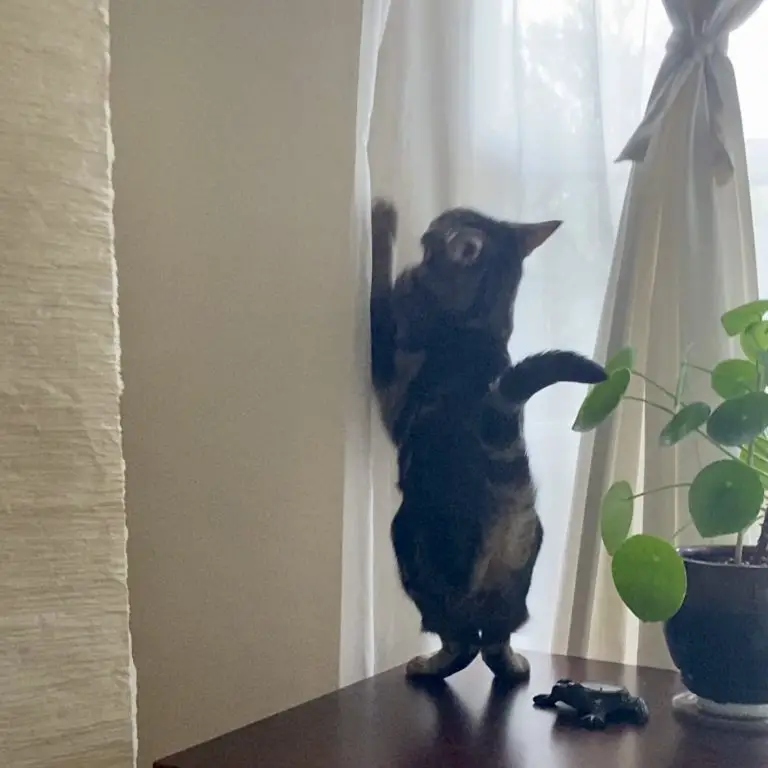How to Cat Proof Your Curtains
So you’re looking for ways to prevent or stop your cat from climbing or scratching your curtains. In this article, we talk about why your cat is doing this and some detailed strategies you can use to save your curtains.
But first, here’s the TL;DR of what you can do:
Yes, curtains are indeed a common part of cat-proofing your home.
There are several things to consider, with a big emphasis on optimizing your space – channeling your cat’s natural behaviors by providing an enriching environment.
This includes vertical spaces, perches, scratchers, and cozy hiding spots, as well as training and playing with your cat regularly.
While there are some things you can do with the curtains themselves, you’re going to get the best bang for your buck by focusing on the enrichment side of things.

Why do cats climb or scratch curtains?
When your cat is doing something unwanted, it is often helpful to take a step back and make sure you understand why they might be doing that thing.
So why is your cat climbing and/or scratching the curtains?
Or, if you’re about to get a cat – Why should you bother investing in cat furniture and scratchers ahead of time?
Because cats have an innate drive to climb and to find places high off the ground to observe their surroundings from, and a basic need to maintain paw and claw health by scratching surfaces.
Punishment and Scolding Don’t Work
No amount of scolding or squirting with water, or any other form of “discipline,” will change your cat’s innate need to climb and scratch.
These things may look like they work, because the cat stops scratching and runs away in that moment. But punishment won’t make the behavior less likely to happen in the future.
So if your solution to the problem is any of those things, you will not actually be solving the problem.
And much worse, you will probably be harming your bond by teaching your cat that you’re not always a safe person to be around.
Kittens are most likely to climb curtains
In addition to the natural drive to climb, kittens and young cats are especially likely to climb the curtains for these reasons:
- They have a huge amount of energy to spend any way they can
- They have a huge amount of curiosity because so much of the world is new to them and, well, they’re cats
- They weigh less than older cats because they are still growing, and this makes it easier for them to climb things using their claws
The good news is that if you provide the right environment and learn some cat training basics, your cat will learn appropriate ways of channeling that climbing and scratching energy.
Provide Appropriate Outlets and Use Positive Reinforcement
The most important part of your strategy for keeping your cat off the curtains is to make sure that, from the very beginning, there are attractive alternatives for climbing, scratching, spending energy, and hanging out in high places.
If you have these things in place from the start of having your cat, you will be way ahead of the game.
A little training and positive reinforcement for using the scratching posts and climbers will make it far less likely your cat will climb or scratch your curtains or furniture.
Positive reinforcement involves rewarding desired behaviors as soon as they happen.
For the current topic, this means giving a treat or love and attention as soon as your cat uses a scratching post or climbs the cat furniture.
Now let’s talk about the details of this two-pronged approach, one piece at a time.
Get Some Cat Furniture
There are many variations on this specialized furniture, including climbers, condos, wall installations, cat trees that look like real trees, and furniture made to look more like typical living room furniture.
Strategic placement of cat furniture will meet your cat’s need for vertical space and the ability to get up high.
As a bonus, many pieces have a scratching post built in. You may want to experiment with placement of cat furniture in the same room as the curtains.
You could start with where it looks best, and adjust from there if it doesn’t seem to be on your cat’s radar.
But don’t forget to do some training before you decide to try another location.
Get Some Scratchers and Scratching Posts
Cats need to scratch, so give them something appropriate to use from Day 1 of bringing home a new cat.
Don’t wait to see if they try to scratch your sofa or curtains. If you don’t provide scratchers, they will use your furniture. It’s that simple.
Scratchers and scratching posts also come in a large variety of types, shapes, and sizes.
My cats love any kind of pressed cardboard scratcher, and they also seem to like the sisal rope scratching posts.
You may need to experiment a little to find the kind of scratcher your cat loves to use.
Place a scratcher or two near your curtains (and near other furniture that might be tempting) to encourage your cat to scratch the right thing.
Then make sure you give your cat plenty of praise and love any time they use the scratcher.
This will reinforce the desired behavior and make them more likely to keep using the scratcher.
Play With Your Cat
The most fun part of this strategy is the play. Get some fun cat toys and devote a few minutes to playing with your cat at least 2 or 3 times per day.
It doesn’t have to be fancy or expensive – you can also improvise with stuff around the house.
Phoebe’s favorite toy is a ratty rope I found laying around the house. And Gandalf loves “playing soccer” with wadded up paper balls.
Whatever you use, have fun with your cat and help him get some exercise and use up some of that energy.
Cat Training is a Part of Effective Cat Proofing
With scratchers and cat furniture in place, train your cat to climb and scratch the right things.
Redirect unwanted behaviors by removing your cat from the scene of the crime and placing them at a scratcher or the cat furniture.
Every time your cat uses a scratcher or climbs the cat furniture, reward this behavior immediately through praise, affection, or treats.
By doing this, you are using positive reinforcement to make this desired behavior more likely in the future, while make the unwanted behavior less likely.
This training is a critical part of an effective strategy to cat-proof the curtains, so don’t skip it.
If you merely get a scratching post and a cat tree but do nothing to reinforce your cat’s use of these things, your curtains may continue to be used and damaged.
Is it too late?
If your cat is already scratching or climbing your curtains, you may be wondering if you’re too late to do anything about it.
It may be too late for the curtains if they’re already damaged, but it’s definitely not too late for you and your cat!
It may take more time, training, and patience though, in order for your cat to learn the new behaviors you’re aiming for.
In this case, you should take the above steps of providing the right environment, and really make sure you understand the training basics of how to shape the behaviors you want to see in your cat.
Changes to Your Curtains that May Help
If you have expensive curtains that you really don’t want to risk getting damaged, there are a few things you can consider to keep them safe.
Sometimes, simply keeping the curtains open when the cat has access to the room does the trick. Your cat may be less interested in the curtains when they are open wide.
Gathering curtains in a bunch so that they are out of reach is probably the easiest thing to try as a way of prevention.
It looks bad, but if you combine this with proper training and enrichment, you may only need to do it for a few weeks or months.
You could also take the curtains down temporarily and hang a sheet or blanket while you give your cat some time to learn to use the vertical spaces and scratchers you’ve placed around your home.
The Best Materials for Curtains and Cats
Whether your curtains are expensive or not, you probably don’t want them to be ruined.
If you have scratchers in place when you first bring your cat home, and you train your cat properly to use them, chances are good you won’t have to worry about your curtains after the first few weeks or months of your cat getting settled.
But if you want to play it safe, the best fabrics for scratch and climb-proof curtains are microfiber, microsuede, and velvet.
These fabrics are effective because the fibers are so tightly woven that cats can’t really sink their claws in. So they look for better options.
Some other fabrics to consider would be canvas, bamboo, and sunbrella.
Alternatives to curtains as window coverings.
The last option as an alternative to curtains would be to install shutters or blinds.
But again, if you’ve done the work of setting up and maintaining an appropriate cat-friendly environment, you are unlikely to need to make such a drastic change.
Last Meows
In this article, we’ve talked about the importance of setting up a cat-friendly environment that promotes climbing and scratching appropriate things, and discourages climbing and scratching of your curtains or furniture.
Ideally, you will have scratchers and climbers in place on the first day you bring your new cat home so that you can train her from the start without picking up bad habits that need to be unlearned.
But it’s not too late if your cat is already scratching or climbing your curtains. In this case, make sure you follow the steps of setting up an environment that channels your cat’s natural behaviors in ways that are ok.
That means strategic placement of cat furniture and scratchers/scratching posts. Then consistently reinforcing desired behaviors by using basic cat training techniques.
If needed, you can also take extra steps to protect existing curtains or replace your curtains with a more suitable material.

